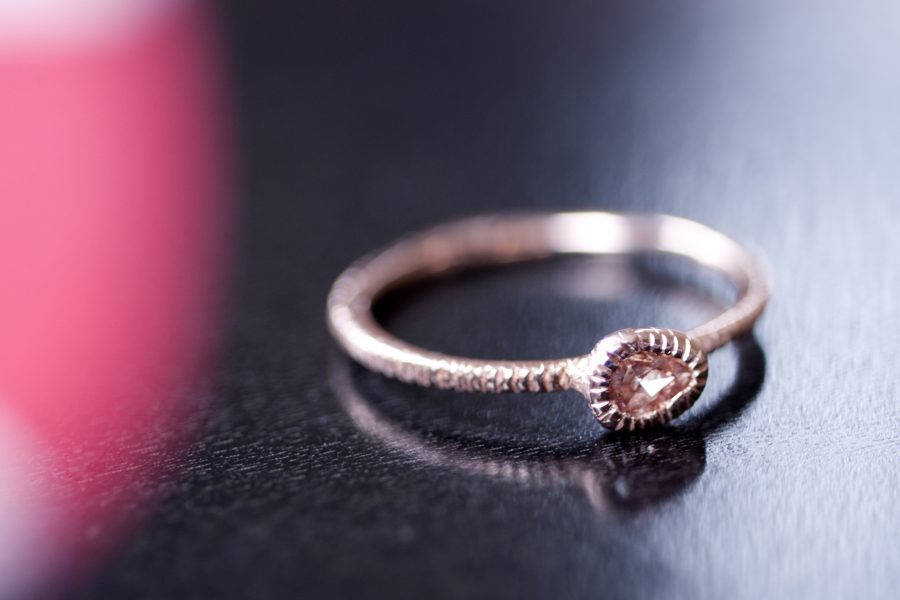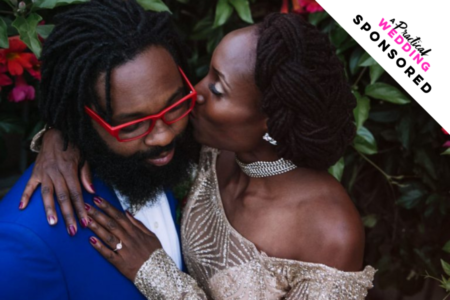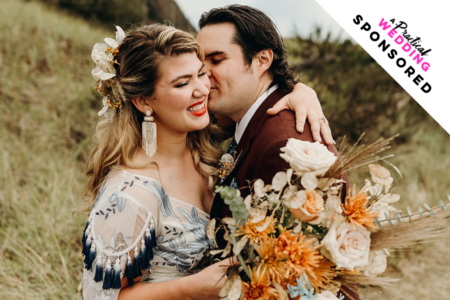Q: I fall into the pre-engaged category—we have a timeline, we’ve looked at rings, our parents are on board—and so far, it has felt pretty smooth. However, we’ve run into one issue that’s tough to reconcile, and I’d love to get an outside perspective on it. I’ve always been involved in social change issues, and one of the first issues I was exposed to (in high school!) was the issue of conflict diamonds. While I’ve always wanted a fairly traditional engagement ring, blood diamonds have been in the back of my mind. And now they’re at the front. My boyfriend hears my feelings on this and acknowledges them, but has also always looked forward to buying a ring and all that comes with it.
I’m trying to reconcile my desires and his. He wants to buy something in person (not online) and unfortunately we don’t have any family heirlooms that could easily solve this problem. I’ve tried to do research on the Kimberley Process and ethically sourced diamonds, but I’m not satisfied with the information I’ve found. It seems contradictory and everyone has a different answer. Have you or your readers struggled with this at all? I’m happy to be shown the error of my ways—honestly, it’d be ideal—but finding a compromise on this one seems like it could be a challenge.
A:You’re right, this one is going to be a challenge. But it sounds like this is an issue you care a lot about, so own the fact that you care about it, and by all means, push for it. Because this is a ring that you’re going to be wearing—or at least have in your collection—for a very, very long time, if not forever. And your opinion on conflict diamonds isn’t likely to change once there’s a ring on your finger.
That’s the emotional stuff, though. On the logistical side of things, your best bet for meeting both your needs and your partner’s needs may be in finding an independent jeweler in your area. Many have studio space that you can visit to see rings in person, and they might also be able to help you in sourcing more ethically minded pieces. In the meantime, to aid in your search and to give you more information on conflict diamonds, we asked APW Sponsor Bario Neal to give us the ins and outs of this complicated subject. (They are one of the best in the business when it comes to environmental responsibility and ethical sourcing. Plus their jewelry is hot.) So grab a drink, sit down, and prepare to take some notes.
APW: We know the Kimberley Process is a method of certifying conflict-free diamonds, but can you give us a little more information about its origin and their process?
Bario Neal: Conflict diamonds, or blood diamonds, captured the world’s attention during the extremely brutal conflict in Sierra Leone in the late 1990s. Proceeds from diamond sales financed arms purchases and prolonged insurrections in Sierra Leone and Angola, which were some of the most brutal of the past decade. Illicit rough diamonds have also been used by rebels to fund conflicts in Liberia, Ivory Coast, the Democratic Republic of Congo, and the Republic of Congo (also known as Congo Brazzaville).
In response, several Southern African countries began developing the Kimberley Process Certification Scheme. Established in 2003, participants of the KP include governments, members of the diamond industry, and civil society organizations. The method was to track rough, not cut and polished, diamonds by attaching a Kimberley Certificate to each shipment, ensuring that it came from a conflict-free mine.
Unfortunately, the Kimberley Process is a faulty system and, alone, fails to prove that a diamond is truly conflict-free. Because of this, we have ruled out reliance the Kimberley Process as the only indicator that a diamond is conflict-free.
APW: So why isn’t the Kimberley Process able to prove whether or not a diamond is conflict-free?
Bario Neal: The goal of the KP was to create a system that prevented the trade of blood diamonds, but the KP is now known to certify blood diamonds as conflict-free, and allow them to enter the supply chain. This is partly a function of its narrow and rigid definition of “conflict diamond,” which is limited to diamonds that fund conflicts against legitimate governments, and does not include violence perpetrated by governments. The KP has yet to broaden its definition.
For example, the Marange diamond fields in Zimbabwe are the most horrifying example of the inefficacy of the KP’s definition of conflict diamond. Rape, torture, and killings have been well documented there. The KP continues to embrace Zimbabwe as a member, and continues to allow diamonds from the Marange fields to enter the supply chain, stamped and sealed with the Kimberley certification. Today, Zimbabwe diamonds are boycotted in the EU and US, but they continue to enter the supply chain through diamond cutters in India.
Additionally, the Kimberley Process does not address environmental destruction—a huge issue in the diamond industry, especially in countries where environmental legislation does not exist. These destructive effects on the environment impact people in serious ways every day, especially those who live near and work in the diamond mines and fields.
Bario Neal promotes the issue of transparency in the gem industry through supplier interviews and in-depth articles on our blog. You can read more about the Kimberley Process here.
APW: What other options do consumers have for making sure they’re purchasing conflict-free diamonds?
Bario Neal: At this point, there are many options other than Kimberley Certification available on the market that more effectively address the ethical issues present in the diamond industry. In our research, we’ve found trusted suppliers that offer traceable diamonds mined in Australia, Canada, and Namibia under preferred environmental and working conditions.
Many diamonds from reliable sellers come with a laser inscription and certificates to document their source. You can start your search by asking retailers about specific diamond brands that certify the origin of the stones, like Kalahari, CanadaMark, or Origin Australia (there are many others).
APW: What do you think about purchasing vintage rings, or reusing diamonds which are already above ground?
Bario Neal: Yes, another approach is to make use of the diamonds that are already above ground by purchasing a ring with a recycled diamond. The flip side to this is that you aren’t supporting the mining communities or the new efforts towards sustainable mining practices. We believe in both recycled and ethically mined diamonds, and we view it as a personal decision to choose one over the other. If you decide to go with a recycled diamond, ask if the diamond recycling process is audited by a third party organization (like SCS) to ensure the stones are recycled, or look for antique diamond cuts like Old Mine or Old European.
APW: Are there other areas of the gem industry where we should be paying attention to ethical practices?
Bario Neal: The act of mining the diamond isn’t the only place where human rights abuses occur. Polishing and stonecutting may be outsourced to poor countries where child labor laws do not exist. They often do not have the correct equipment to avoid extreme health hazards associated with stonecutting and polishing. Look into companies who work with organizations like The Jeweltree Foundation and Open Source Minerals that track diamonds from mines to cutting facilities to vendors and to jewelers.
Kerin Jacobs of The Raw Stone stated in a recent article on ethical gem cutting in Jaipur that there are only two ways to ensure that gems are cut ethically. The first is to have your gems cut by an independent professional in the US, UK, Israel, or Australia. The second is to travel to one of the countries where gems are more commonly cut to “find a safe and well-kept facility employing only adults, and to sit there, watch, and wait for each and every gem to be cut and polished.” Kerin did exactly this, and with relative ease she found a small family gem cutting business with safe working conditions.
In lieu of traveling the world to watch your diamond get cut, you can opt for a Jeweltree Certified diamond and let them do the auditing work for you.
APW: Bario-Neal recently started offering certified Fairmined gold, in addition to your ethically sourced stones. Can you tell us a bit more about ethical gold, since it appears to be a newer trend in the jewelry market?
Bario Neal: Fairmined gold certification is supported by the Alliance for Responsible Mining’s (ARM) vision for responsible Artisanal and Small-scale Mining (ASM). That vision encompasses a “formalized, organized and profitable activity that uses efficient technologies, and is socially and environmentally responsible.” Fairmined gold has only recently become available to the US market, and we are proud to be one of the first jewelry companies to develop a relationship with sources for Fairmined gold. You can read more in depth on Fairmined gold on our blog.
Ethical gold is very new to the jewelry market. As of now, ethical gold is really only sold by small, specialized jewelry companies like Bario Neal, which make up a very small portion of the jewelry industry. Essentially, the supply of ethical gold is currently greater than the demand, though as customers like you become more invested in supporting ethical gold this balance will shift in its favor.
If you have questions about wedding planning, submit them here.







